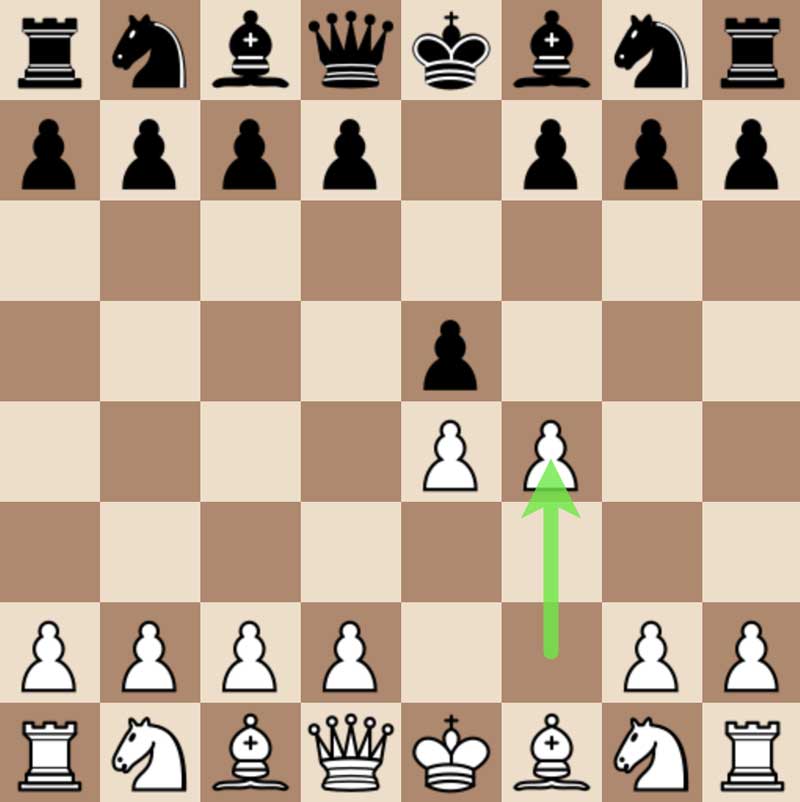There are clear reasons why the King’s Gambit is rarely played these days. In this article, you will see why it’s not a great choice for White. You will also learn a simple and practical way to play against this line.
But to show you why it’s hardly played, let’s understand what the opening is and what is White’s main intention in it.
What is The King’s Gambit?
The King’s Gambit arises after 1.e4 e5 2.f4. This opening was popular in the romantic era of chess, where sacrifices and attacks were given more preference over good defense. In that period, White often won many games by being aggressive in the opening. But as defensive techniques improved, Black found better ways to handle this opening.
What Is White’s Main Idea In The Kings Gambit?
White’s main idea is to develop their pieces to active squares and launch an attack as fast as they can. After Black takes with 2…exf4, White can also gain control over the centre with d4 at the right moment. 2…exf4 also opens up the f-file for White, so that after they castle, the rook on f1 is automatically placed on an open file.
If given a chance, White wants to play Nf3, Bc4, 0-0, d4, Bxf4 and Ne5 with a great attack.
The Drawback Of King’s Gambit
These are 2 main drawbacks of this line –
- With 2.f4, White weakens the h4-e1 diagonal, often allowing the Black queen to jump to h4 with a check.
- White is sacrificing a healthy pawn and if they can’t prove any compensation for the lost pawn, they will be materially behind.
Black’s Strategy To Play Against The King’s Gambit
Black’s strategy revolves around exploiting the above mentioned drawbacks. It’s important for Black to develop their pieces fast, so as to not fall behind in development and come under a heavy attack.
There are two different approaches Black can take.
- The proactive option 2…d5
- The pawn-grabbing 2…exf4
Although 2…d5 is a great option, it does involve memorizing some lines, especially after 3.exd5 e4.
The second option 2…exf4 is much more practical and easier to remember with a little practice with a little practice. It also follows a famous chess maxim, “The best way to refute the gambit is to accept it.”
Best Way To Play Against The King’s Gambit – 2…exf4.
With 2…exf4, Black accepts the challenge and asks White to show whether they have enough compensation for the pawn. White has two most important ways to continue, 3.Bc4 and 3.Nf3. Most of the other lines are bad where White is struggling to prove the compensation. Let’s examine their options closely –
Against White’s Response 3.Nf3 Play 3…Nf6
3.Nf3 is the move you’ll most likely face. In that case 3…Nf6 is easy to remember and play, attacking the pawn on e4. This is known as the Schallop Defense. The point is that after White goes e5, you go …Nh5 and from there your knight defends the f4-pawn.
In the King’s gambit, the Black pawn on f4 often restricts White’s pieces. As a result, White is often left cramped for space. For example, it controls the square e3, and stops White’s dark squared bishop from developing. A possible line after 3.Nf3 Nf6 could be –
4.e5 Nh5 5.d4 d6 6.Bc4 Be7! (It’s important to continue development)
Black can always defend their h5-knight with …g6. The main strategy in this line for Black is to continue their development and focus on keeping the f4 pawn alive for as long as they can. White often has problems recapturing it and once Black is fully developed, the extra pawn makes its presence felt.
Against White’s Response 3.Bc4 Play 3…Nf6
Against 3.Bc4, Black again has different options with 3..Qh4+, 3…d5 or 3…Nf6. All three of them are fine, but 3…Nf6 is easy to remember and the play is very logical.
Black’s main plan is to fight in the centre with …d5. They often play the move …c6 in order to support this central pawn advance. One sample line could run –
3.Bc4 Nf6 4.Nc3 c6! (preparing …d5) 5.d4 d5 6.exd5 cxd5 7.Bb3 Bd6 (protecting f4) 8.Nge2
If instead of 8.Nge2, White plays 8.Nxd5 Black takes 8…Nxd5 9.Bxd5 and then gives a discovered check 9…Bb4+. White is forced to play 10.c3, after which Black takes 10…Qxd5 with an advantage.
8…0-0 9.0-0 g5! (protecting the pawn on f4). 10.Nxd5 Nxd5 11.Bxd5 Nc6.
Black has a pleasant position thanks to the f4-pawn that restricts White’s pieces. Later Black can continue …Ne7-Ng6 and roll the kingside pawns. In practice, Black has decent chances to win the game.
Why Is This Opening Barely Played?
- As you can see from above, Black has too many great options to respond, all of them in which they have excellent fighting chances to gain the upper hand.
- In serious tournaments, a lot of top players want to play for a win with White and hold a draw with Black. The King’s Gambit doesn’t offer enough winning chances for White against a well-prepared opposition. Also there’s a risk of getting a worse position with the White pieces. Hence a lot of top players avoid playing this line and use it as a surprise weapon in most cases.
- It’s quite easy for Black to achieve equality (or sometimes even an advantage) in most lines, if they are well-prepared. Also as you saw, the lines are quite easy to remember. Add computer preparation to that, and you have a deadly weapon to use against the King’s Gambit.
- White has many better choices available at their disposal after 1.e4 e5. They could play the Ruy Lopez, Scotch Game or the Italian Game, all in which they have decent chances to gain a small edge. For this reason, most players focus their efforts on these openings, and not on sidelines like the King’s Gambit.
For these reasons, the King’s Gambit is hardly played these days.


